Latissimus dorsi muscle
What is Latissimus dorsi muscle?
The muscle known as the latissimus dorsi (the lats muscle’ or ‘lats’) is the broadest in the human body. Except for the trapezius, it covers almost all of the muscles in the posterior trunk of the back.
The latissimus dorsi muscle is a member of the superficial layer of the extrinsic back muscles, along with the levator scapulae, trapezius, and rhomboid muscles.
The latissimus dorsi muscle is one of the scapular motion muscles, so it serves a functional purpose. This muscle can move the shoulder joint by pulling on the inferior angle of the scapula in various directions; arm extension, internal rotation, and adduction. In addition, it is one of the primary stabilizers of the spine during its various movements and an accessory respiratory muscle.
Origin of Latissimus dorsi Muscle
The lumbar and lower thoracic regions of the back are covered by the latissimus dorsi muscle. Four specific parts of this muscle can be determined by origin:
Vertebral part: beginning from the spinous process of the seventh to twelth thoracic vertebrae and the thoracolumbar fascia
Costal part: originating in between nine and twelve ribs
Iliac part: beginning with the iliac crest.
Scapular part: begin at the inferior scapula angle (inconstant)
The proximal humerus is where all of the fibers separate. The upper vertebral and scapular fibers travel nearly horizontally, the lower vertebral and iliac fibers obliquely, and the coastal fibers travel nearly vertically.
Insertion of Latissimus dorsi Muscle
The fibers form a spiral around the teres major muscle, inserting the lower portion of the latissimus dorsi proximally at the humerus and the upper portion more distally. Between the pectoralis major and teres major muscles, all of the fibers attach to the floor of the intertubercular sulcus of the humerus.
The following mnemonic can be used to quickly recall the relationship between the latissimus dorsi, pectoralis major, and teres major muscles as they insert into the intertubercular sulcus:
Lady between two majors:
- Lady: Latissimus dorsi
- Majors: Teres major, pectoralis major.
Relations
The serratus posterior muscles are covered by the latissimus dorsi muscle, which is located superficially in the lower two-thirds of the trunk. The latissimus dorsi muscle is located below the teres major muscle. These two muscles’ adjacent fibers are connected, but they are separated by a bursa that runs toward their humeral attachments. The posterior axillary fold is formed by the latissimus dorsi and teres major, which run from the scapula to the proximal humerus. When the arm is adducted against resistance, the fold becomes more prominent. The whole inferolateral border of the latissimus dorsi can be followed during this motion to its connection to the iliac crest.
The medial margin of the lumbar triangle (of Petit) consists of the lower portion of the latissimus dorsi’s lateral margin. The iliac crest and the external abdominal oblique muscle complete the triangle laterally and inferiorly. The floor of this area is made up of the internal abdominal oblique muscle.
Another significant anatomical feature is the latissimus dorsi muscle; the triangle of auscultation. The trapezius (superior), the medial border of the scapula (medially), and the latissimus dorsi (inferior) are the boundaries of this space. When a person folds their arms across their chest and bends their trunk forward, the lower pulmonary lobes become subcutaneous within the auscultation triangle. This makes them accessible for stethoscope auscultation of respiratory sounds.
Innervation
The thoracodorsal nerve (C6-C8), a branch of the brachial plexus, is responsible for carrying the innervation.
Blood supply
The thoracodorsal corridor (a continuation of the subscapular vein), supplies the latissimus dorsi muscle. It enters the muscle on its costal surface, a few centimeters from the subscapular artery and medial to the lateral border.
The lat muscle is supplied by the first to third lumbar arteries, perforating arteries of the 9th to 11th posterior intercostal arteries, and the thoracodorsal artery.
Functions
The latissimus dorsi muscle performs three actions on the shoulder joint because its fibers are aligned in multiple directions:
The complex functional activity of the latissimus dorsi muscle is determined by these actions: It effectively extends the flexed arm; It adducts and internally rotates the arm; The pectoral girdle as a whole is pulled back when the humerus is pressed against the scapula. it is a climbing muscle, paddling muscle, and swimming muscle.
The latissimus dorsi has several important supporting functions, including:
During humeral movements on the shoulder joint, the latissimus dorsi stabilizes the scapula against the thoracic cage. The latissimus dorsi helps to pull the trunk forward in people who use crutches and have their humerus as the fixed point while standing. If the arms are fixed above the head, they can work together with the pectoralis major to raise the trunk upward.
The pelvis is also lifted as a result of this action. This action makes it possible for paraplegics to move their trunks and pelvis.
Compressing the accessory muscle of expiration, the rib cage, aids in forced expiration. As a result, the coughing muscle experiences increased strain during coughing episodes.
Clinical significance
Tight latissimus dorsi is a supporter of constant shoulder pain and ongoing back pain. Since the latissimus dorsi interfaces the spine to the humerus, tightness in this muscle can appear as either sub-standard glenohumeral joint (shoulder) capability which prompts ongoing pain, or tendinitis in the tendinous fasciae interfacing the latissimus dorsi to the thoracic and lumbar spine.
It is possible to use the latissimus dorsi as a source of muscle for pectoral hypoplastic defects like Poland’s syndrome or breast reconstruction surgery (like the Mannu flap). One of the symptoms of Poland’s syndrome can be an absence or hypoplastic latissimus dorsi.
Cardiac support
Cardiomyoplasty is a procedure that may support the failing heart in heart patients who are not candidates for cardiac transplantation and have low cardiac output. This strategy includes wrapping the latissimus dorsi muscles around the heart and electrostimulating them in synchrony with ventricular systole.
Injury
The latissimus dorsi is rarely injured. They are more common in baseball pitchers. By visualizing the muscle and movement tests, a diagnosis can be made. The diagnosis will be confirmed by an MRI of the shoulder girdle. Rehab is used to treat muscle belly injuries, while surgery or rehab can be used to treat tendon avulsion injuries. Patients typically return to play without any functional losses, regardless of treatment.
Paralysis of latissimus dorsi muscle
The latissimus dorsi could be affected by damage to the brachial plexus because it could paralyze the thoracodorsal nerve. In contrast, a single nerve injury, such as one caused by trauma, is rare. The absence of muscular relief in the back and the posterior axillary fold are clinical signs. Although the remaining shoulder musculature typically makes up for the weakness that the paralysis of the muscle may cause in everyday life, the weakness can be slight.
Assessment
Palpation
The axilla’s posterior border is constructed by the latissimus dorsi muscle on its lateral aspect. During resisted arm adduction, it is felt to contract. The lesser tuberosity crest is where its insertion is located anteriorly. The latissimus dorsi muscle can be made to stand out about the thorax by asking a patient to raise his or her arm to 90 percent flexion and holding it steady against upwardly directed pressure. By asking the patient to cough and holding the posterior axillary fold between the thumb and index finger, doctors can palpate for a muscle contraction.
Muscle Testing
The latissimus dorsi muscle is tested in a prone position with the arm adducted and the elbow extended fully. The forearm is subjected to resistance during slight flexion and abduction.
When the upper extremity is flexed into an overhead position, such as reaching for something on a high shelf, the back will extend and rotate if the latissimus dorsi is short or tight. The overhead position of the upper extremity can be achieved by accommodating the spine’s extension and rotation.
Latissimus dorsi muscle stretching
Wall-assisted latissimus dorsi stretch
This is a stretch that uses a wall to assist push your shoulder into deeper shoulder flexion. That is by putting one hand on the wall in front of you. Flex forward at the hips to lift the arm in front of you. Maintain for 3-5 breaths or up to 30 seconds. Calm down and repeat as needed.
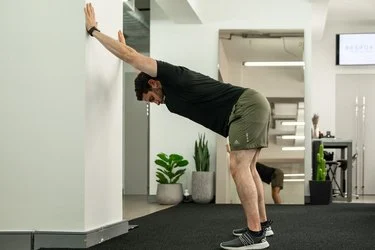
Leaning stretch
This is a stretch for the quadratus lumborum muscle as well as the latissimus dorsi and other muscles in the back and shoulders.
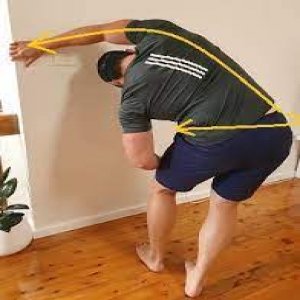
PNF wall-assisted latissimus dorsi stretch
A wall is used in this Peripheral Neuromuscular Facilitation stretch to push your shoulder into deeper flexion. That can be accomplished by sticking a hand on the wall in front of you. To raise the arm in front of you, flex your hips forward. Stretch for 5-7 seconds at a time. The next step is to fully engage your shoulder muscles by pressing your hands into the wall for 5-7 seconds. Remain calm and repeat as necessary.
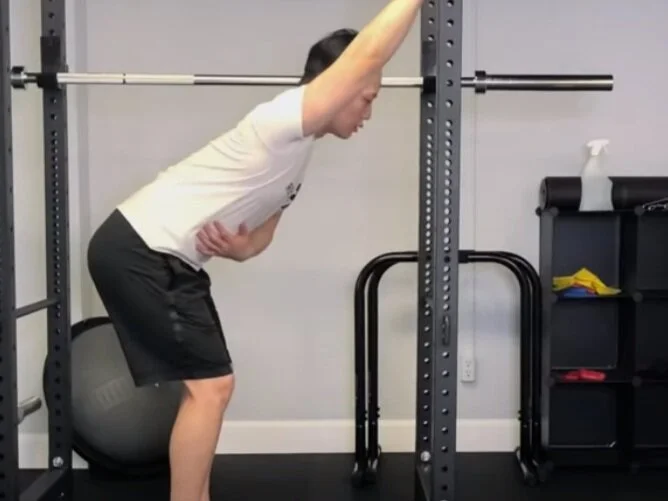
Seated side lats stretch
The latissimus dorsi muscle is the target of this stretch. To have a successful stretch make certain to keep the buttock established on your seat during the whole action. Reach over your head with one arm while using the other to support your body as you bend over to the opposite side of the target side.
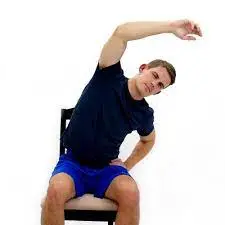
Standing side stretch
A standing doorway-assisted stretch that targets the muscles in your shoulders and back
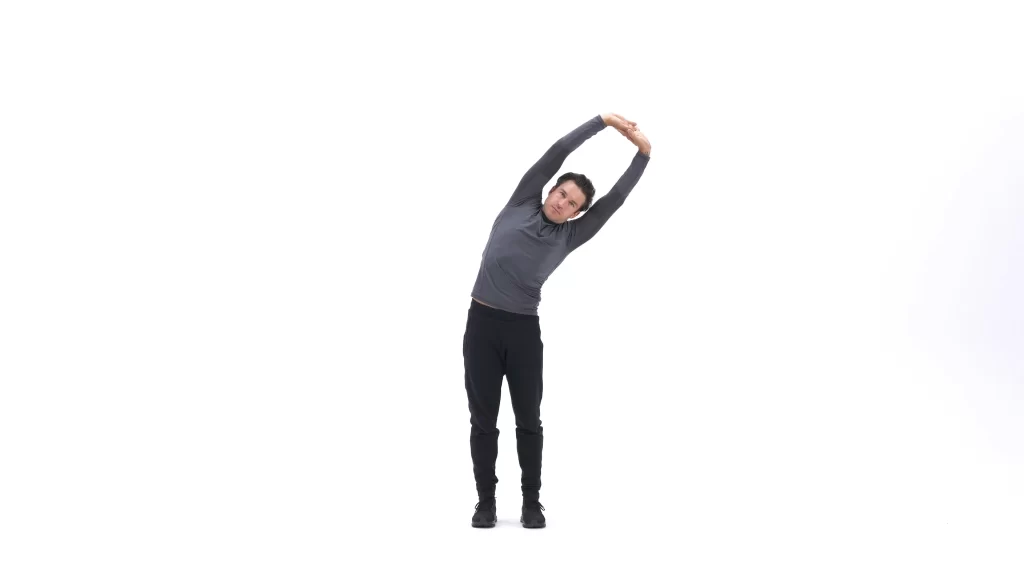
Swiss ball PNF lats stretch
This is a proprioception neuromuscular help practice for the latissimus dorsi muscle to further develop end-range strength and mobility in shoulder flexion. With one hand on a Swiss ball or stability ball, begin on your knees. Start to incline advances to participate in a light stretch and hold for 5-7 seconds. The next step is to engage the latissimus dorsi by compressing the ball for 5-7 seconds while remaining in the same position. Lean forward once more and ease off the contraction to deepen your range into a light stretch. Recount until full reach is accomplished or for up to 5-7 recounts.
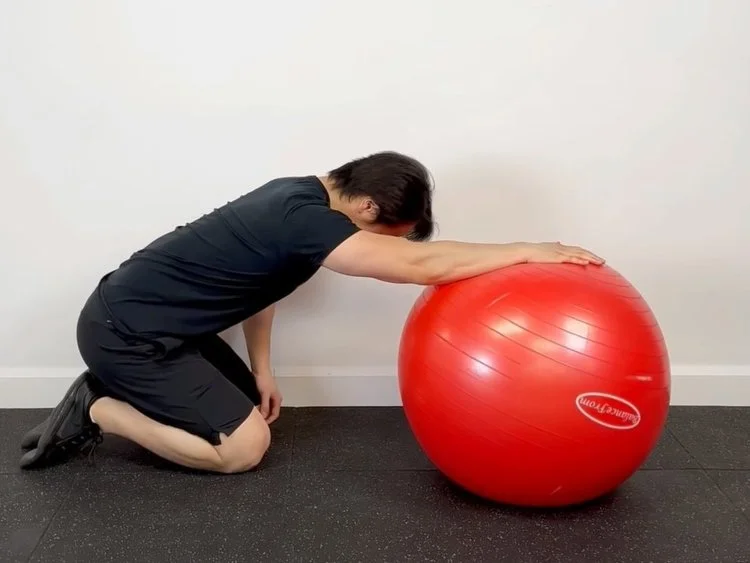
Foam roller prayer stretch
A foam roller is used in this latissimus dorsi stretch and thoracic extension mobility exercise. Make sure to perform this exercise on a mat or soft flooring. Sit back on your calves and place your hands on the foam roller. Stretch your arms overhead while placing the palms’ bases on the foam roller. Your hands will be wider than the distance between your shoulders. Press your hands downwards into the foam roller for five seconds after holding the stretch for five seconds.
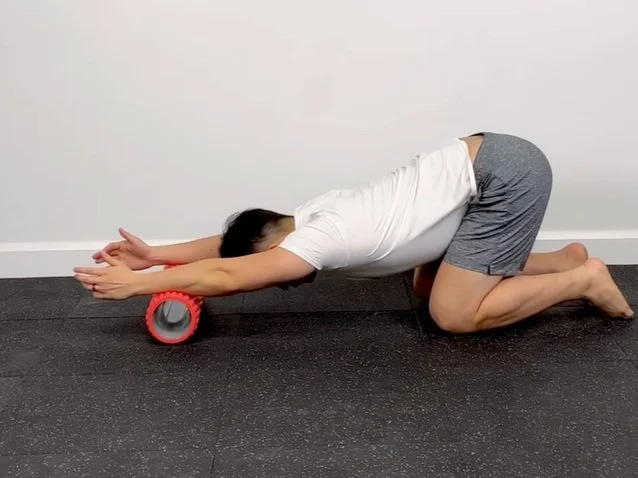
Child pose foam roll
Using a foam roller, this latissimus dorsi stretch and thoracic extension mobility exercise modify the Children’s Pose exercise. Make sure to perform this exercise on a mat or soft flooring. Sit back on your calves and place your hands on the foam roller. Stretch your arms overhead while placing the palms’ bases on the foam roller. Your hands will be wider than the distance between your shoulders. Press your hands downwards into the foam roller for five seconds after holding the stretch for five seconds.
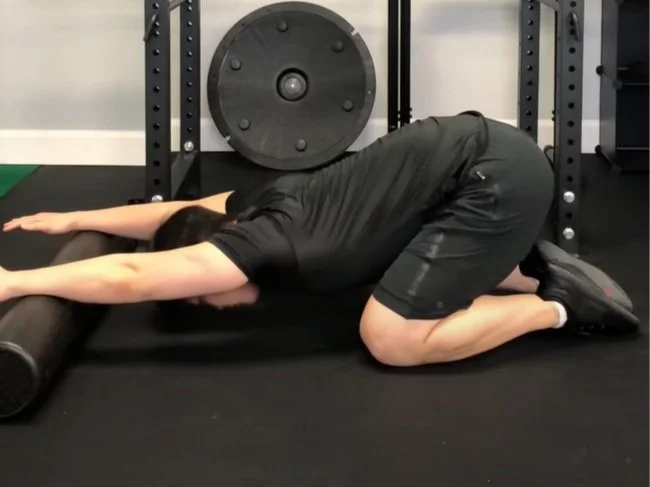
Leaning lats stretch
In externally rotated shoulder positions, this stretch can be done lightly before working out to increase overhead mobility. Grab a racked barbell or handrail with the arm of your target side using an underhand grip. Using the other hand, strengthen the grip. Slouch with the hips and downwards with the middle to loosen up the shoulder and back.

Latissimus dorsi muscle strengthening exercise
Supine lat pull down
Using a band is a strengthening exercise for the latissimus dorsi. It is a modified version of the standard lat pull-down that uses a bench to isolate and support the latissimus dorsi muscle. Begin by lying down on your back with an overhead band. Pull the band toward your chest while leading with your elbows. To finish a repetition, slowly reverse the motion.
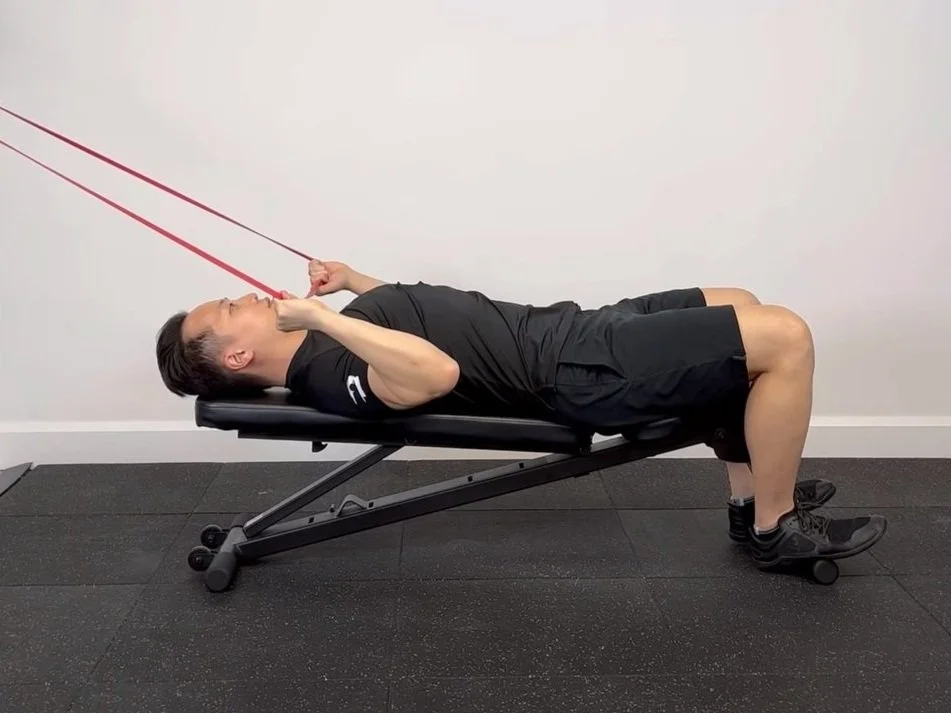
Isometric lat pulldown
An isometric contraction is used in this latissimus dorsi activation drill to warm up the muscle. Begin by sitting next to an exercise bench and putting your fist in the air and resting your elbow on it. Using your elbow, apply downward pressure to the bench to cause the latissimus dorsi to contract during shoulder adduction. To compete for a repetition, hold this contraction for 5-7 seconds before relaxing. Recount as required.
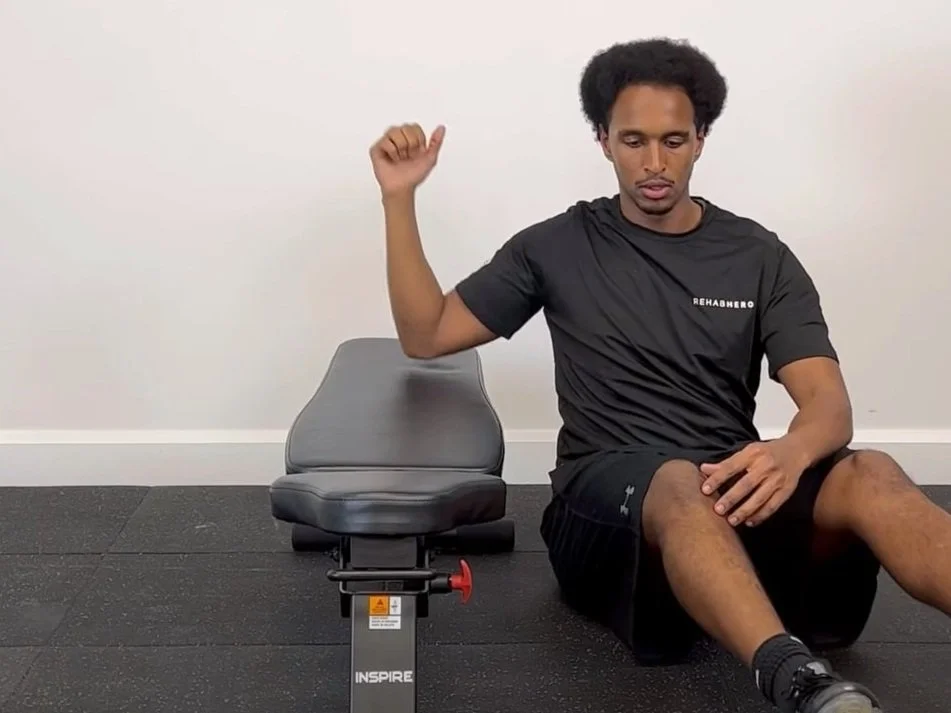
Standing lat pull down
This is a latissimus dorsi muscle-strengthening exercise. Start by standing with a strength band or pull-up assist anchored above and in front of you. Pull the band toward your chest while leading the movement with your elbows by grasping it with both hands. Keep the center maintained and keep a marginally expanded curve through the spine. To complete a repetition, slowly allow the band to pull your arms back to their full range.
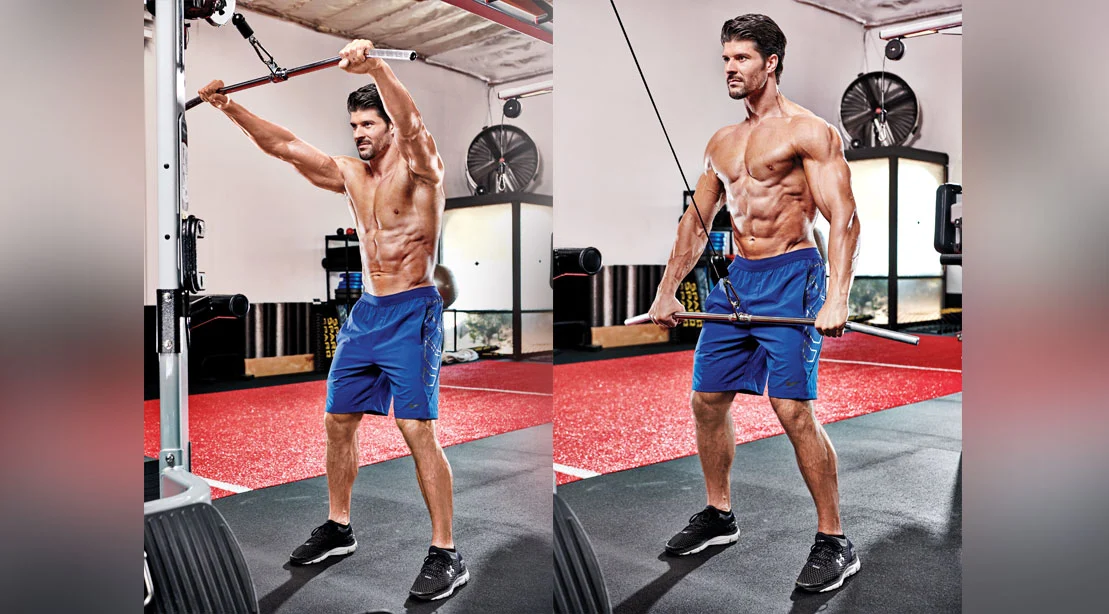
Lat pull single-leg glute bridge
The standard glute bridge has been modified for this exercise. To take advantage of the Back Functional Line—the fascial connection to the glutes—and to stabilize the low back, this exercise has been modified to include Latissimus Dorsi engagement. Engage the latissimus dorsi by pulling a band from above while lying on your back with straight arms. With your knees bent 90 degrees, keep your heels planted. Lift one foot off the bottom and raise your pelvis with one leg.
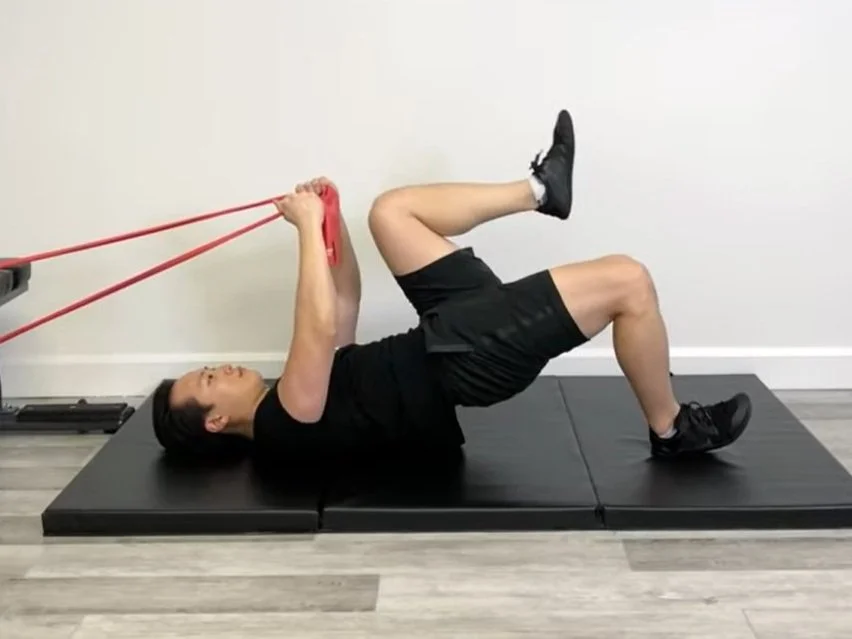
Dumbell pullover
This exercise can be altered to target the pectoralis or latissimus dorsi muscles. Place your upper back and neck on a bench so that they rest horizontally. Bridge the body into a neutral position so that the spine is held there. Lift your arms above your head while you are holding a weight. To complete a repetition, pull the weight back up until it is above your chest.
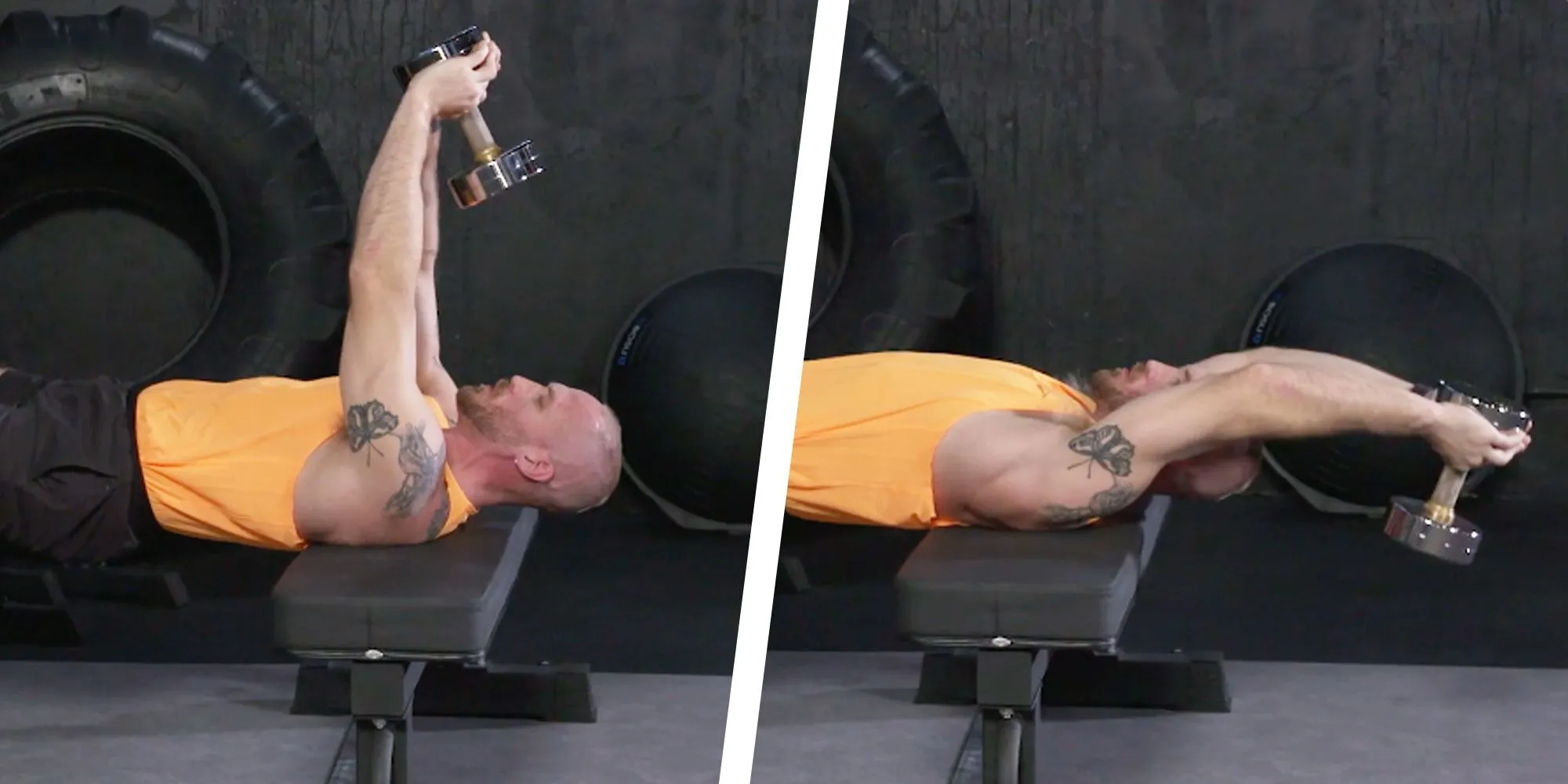
Banded lat pullover
A pull-up assist band or strength band is used in this exercise for strengthening. Begin by lying down on your back with an overhead band. Pull down with straight arms toward your thighs as you grasp the band with both hands. Lead the action with your elbows to raise latissimus dorsi responsibility.
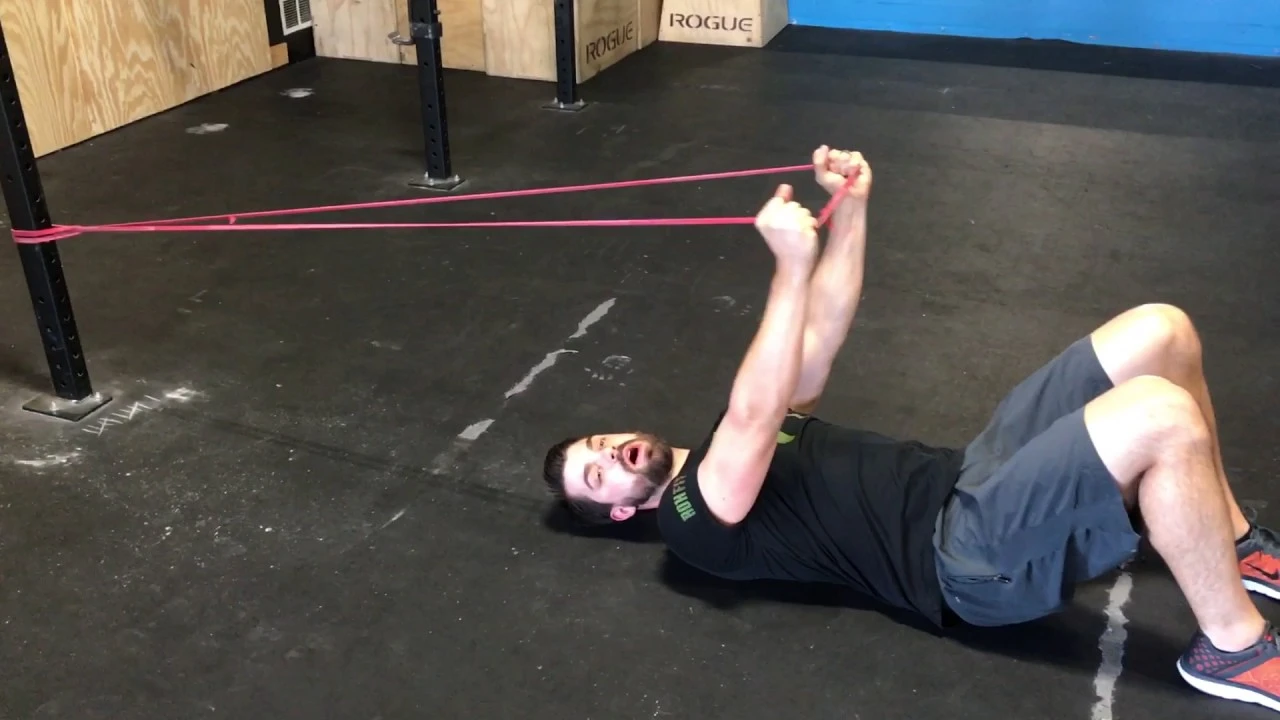
Isometric row squats
While doing a squat, is a warm-up exercise that works the latissimus dorsi muscle. When doing squats, the goal is to use this large muscle to support your core and stabilize your spine, which becomes more important the more weight you put on your squat. Any back pain caused by squatting can be alleviated by engaging the latissimus dorsi. Perform regular squats with a neutral spine while tying a light strength band in front of you and pulling it into a static row position for this exercise.
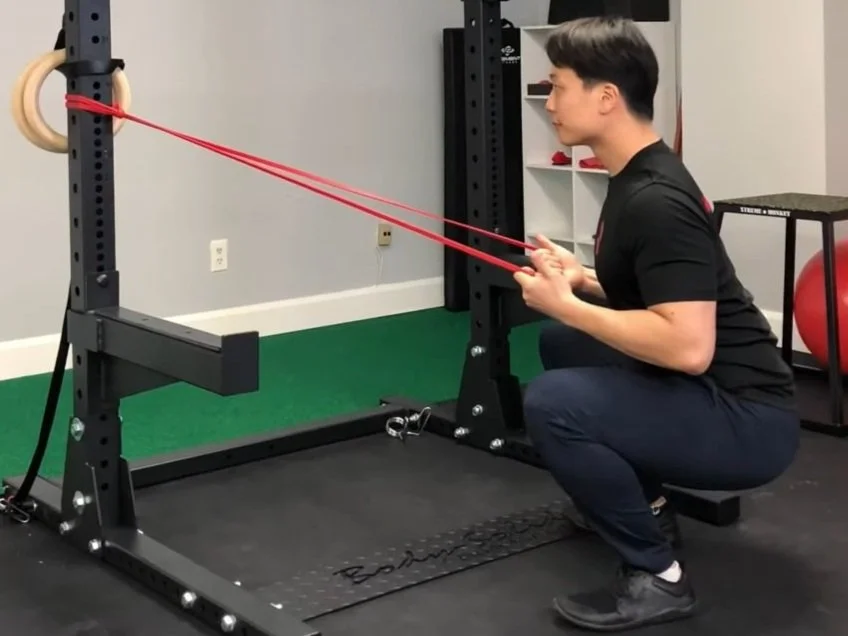
Banded lat pulldown (kneeling)
This is a latissimus dorsi muscle-strengthening exercise. With a pull-up assist or strength band anchored above and in front of you, begin by kneeling on a cushioned surface. Pull the band toward your chest while leading the movement with your elbows by grasping it with both hands. Keep the center propped and keep a marginally expanded curve through the spine. To complete a repetition, slowly allow the band to pull your arms back to their full range.
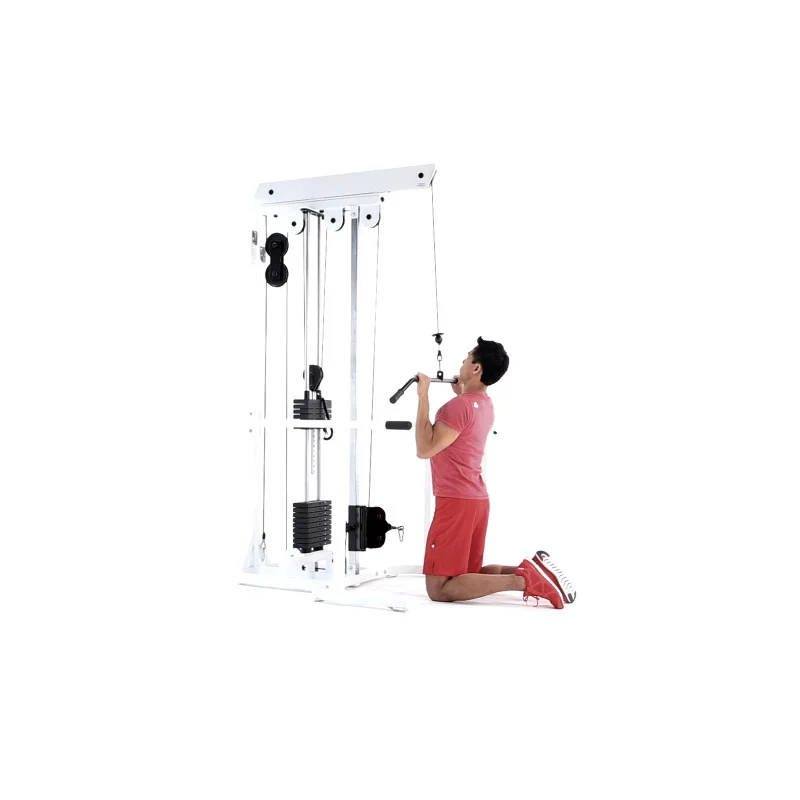
Squat and row
The functional backline muscles, specifically the gluteus maximus and latissimus dorsi, are the focus of this cross-kinetic chain exercise. Begin by grasping a band with both hands and securing it to a stable object in front of you. To complete a band while standing, pull the band. Then, simultaneously extend the arms and squat down. As you get back up, pull the band once more.
Banded shoulder distraction
This is an activity used to loosen up the glenohumeral joint case. Wrap one end of a band around your wrist and a stable object above you, like a squat rack frame. Relax all of your shoulder muscles as you lean back with your hips. Hold for three to five breaths while appreciating the gaping in your shoulder joint.
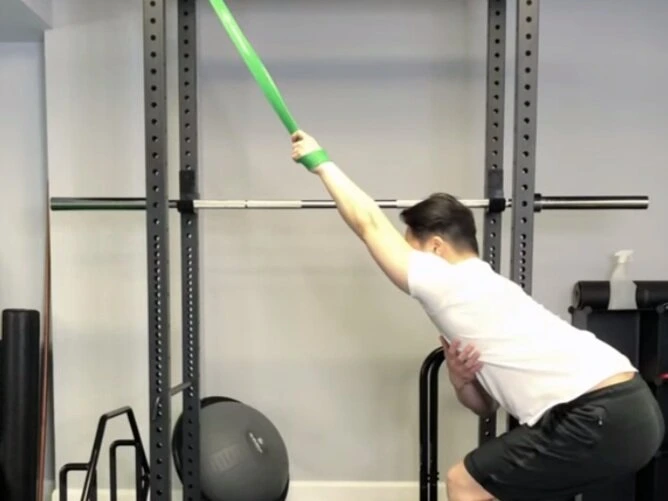
Wall row
This is a bodyweight isometric exercise for strengthening your shoulder and back muscles. Begin by bending your knees in front of you while leaning back against a wall. To lift your back off the wall, drive your elbows into the wall behind you and hold for up to seven seconds. Gradually get your once again to the wall and rest for 5-7 seconds before recounting the following recount.
FAQ
Why does it have the name latissimus dorsi?
The latissimus dorsi muscle is a flat, wing-like muscle that stretches from the lower thoracic vertebrae, lower ribs, scapula, and iliac crest to a groove in the upper arm bone (humerus). Its name comes from the Latin words latus, which means wide, and dorsi, which means back.
The opposite of latissimus is what?
The latissimus dorsi is antagonistic to the deltoid, supraspinatus, biceps brachii, coracobrachialis, pectoralis major, infraspinatus, and teres minor muscles because these muscles perform these movements.
In anatomy, what is latissimus?
Anatomy. a large, flat muscle on each side of the midback that pulls the arm backward and downward and turns the arm’s front toward the body.
Which kind of latissimus dorsi is it?
The latissimus dorsi, a type V muscle, has a single dominant, long vascular pedicle that extends at its insertion from the thoracodorsal artery.
Is the dorsi latissimus a core muscle?
Although it is frequently referred to as a shoulder muscle, the latissimus dorsi plays a significant role in trunk movement. It is essential to be familiar with all of the muscle attachments when training the core so that you can incorporate them into your training regimen.

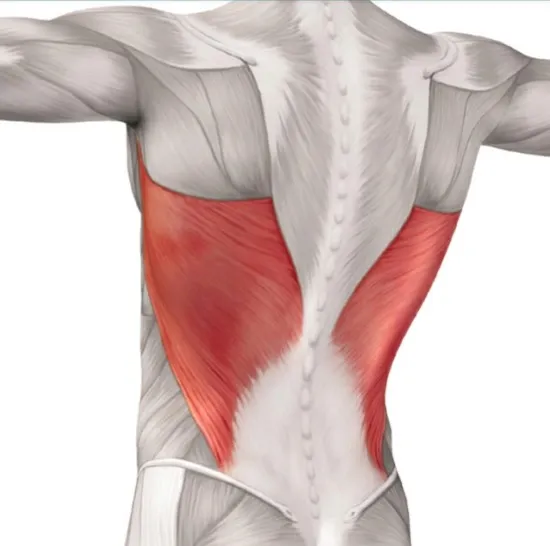
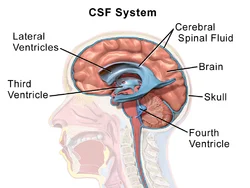

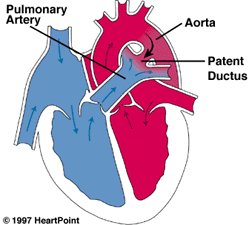

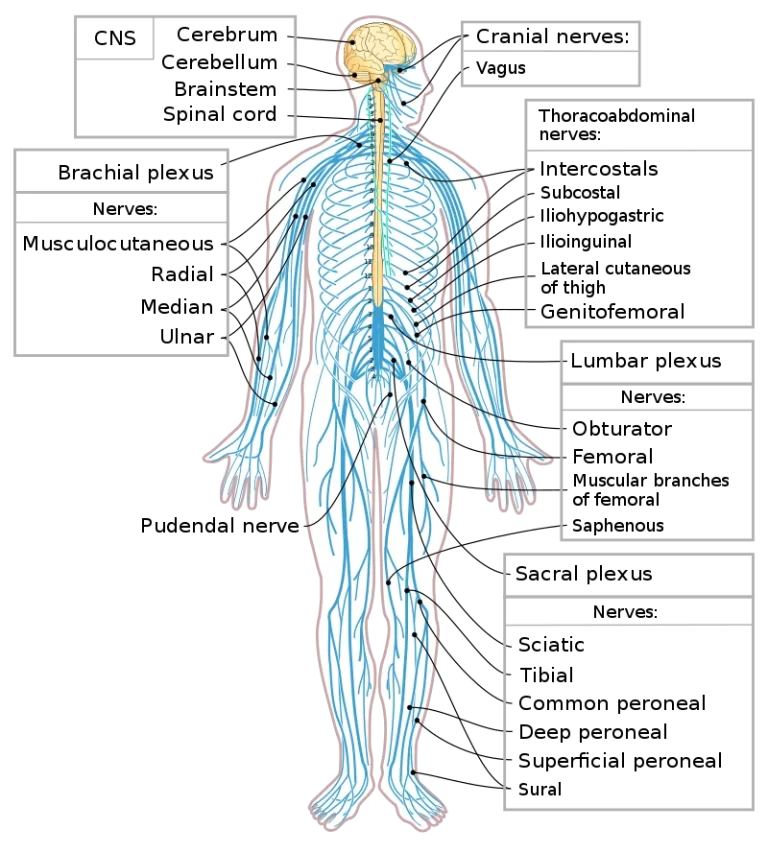

10 Comments